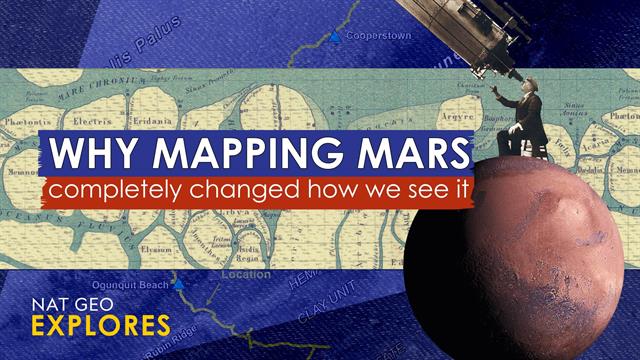From Mars Charts To Martian Dreams: A History Of Cartographic Disputes

Welcome to your ultimate source for breaking news, trending updates, and in-depth stories from around the world. Whether it's politics, technology, entertainment, sports, or lifestyle, we bring you real-time updates that keep you informed and ahead of the curve.
Our team works tirelessly to ensure you never miss a moment. From the latest developments in global events to the most talked-about topics on social media, our news platform is designed to deliver accurate and timely information, all in one place.
Stay in the know and join thousands of readers who trust us for reliable, up-to-date content. Explore our expertly curated articles and dive deeper into the stories that matter to you. Visit NewsOneSMADCSTDO now and be part of the conversation. Don't miss out on the headlines that shape our world!
Table of Contents
From Mars Charts to Martian Dreams: A History of Cartographic Disputes
The red planet has captivated humanity for centuries, sparking imaginations and fueling ambitious exploration plans. But our understanding of Mars, even in its visual representation, hasn't been a straightforward journey. The history of Martian cartography is riddled with disputes, reflecting not only scientific advancements but also the inherent biases and limitations of observation across different eras. From early telescopic sketches to high-resolution satellite imagery, the mapping of Mars has been a contentious, evolving process.
Early Attempts and the "Canals" Controversy
Early attempts at Martian cartography relied heavily on telescopic observations, often limited by technology and atmospheric conditions. These early maps, while crude by today's standards, were groundbreaking for their time. However, they also sowed the seeds of some of the most enduring controversies. The most famous example is the "canals" controversy. Observations by astronomers like Giovanni Schiaparelli, who used the Italian word canali (channels), were misinterpreted by others, notably Percival Lowell, as evidence of artificial waterways built by a Martian civilization. This misconception fueled decades of speculation and shaped popular conceptions of Mars, even influencing science fiction narratives. The debate highlighted the importance of rigorous observation and interpretation in scientific mapping.
The Space Age and the Rise of Precision
The launch of space probes into Martian orbit revolutionized our understanding of the planet's surface. Missions like Mariner 9 and Viking provided unprecedented detail, revealing a landscape far more complex and geologically active than previously imagined. High-resolution imagery challenged earlier interpretations and sparked new debates. The identification of various geological features—volcanoes like Olympus Mons, vast canyons like Valles Marineris, and polar ice caps—required a reassessment of existing maps and the development of new cartographic techniques. This era marked a shift from speculative interpretations towards scientifically grounded representations of the Martian terrain.
Modern Mapping and Ongoing Challenges
Today, sophisticated spacecraft like Mars Reconnaissance Orbiter (MRO) and Mars Express continue to provide invaluable data for Martian cartography. High-resolution cameras, spectrometers, and radar systems allow for the creation of incredibly detailed maps, revealing subtle geological features and subsurface structures. However, challenges remain. The sheer volume of data generated requires advanced processing techniques and sophisticated software. Furthermore, the integration of data from various instruments and missions requires careful calibration and standardization to ensure accuracy and consistency across different datasets.
- Data Integration Challenges: Combining data from various sources—including different instruments and missions—presents significant challenges in creating a unified and consistent map.
- Temporal Changes: The Martian surface is not static; changes due to dust storms, seasonal variations, and even potential geological activity require regular updates to maintain map accuracy.
- Nomenclature Disputes: The naming of Martian features is an ongoing process, subject to debate and international agreements.
The Future of Martian Cartography
As we move towards human exploration of Mars, the demand for increasingly accurate and detailed maps will only intensify. Future missions will rely on advanced technologies, including autonomous mapping systems and robotic exploration, to enhance our understanding of the planet's surface. The development of 3D models and interactive maps will further enhance the visualization and analysis of Martian data. The legacy of cartographic disputes on Mars serves as a reminder of the iterative and evolving nature of scientific discovery. The history of Martian mapmaking showcases how technological advancements and critical analysis constantly refine our understanding of this enigmatic planet and shape our dreams of future exploration.

Thank you for visiting our website, your trusted source for the latest updates and in-depth coverage on From Mars Charts To Martian Dreams: A History Of Cartographic Disputes. We're committed to keeping you informed with timely and accurate information to meet your curiosity and needs.
If you have any questions, suggestions, or feedback, we'd love to hear from you. Your insights are valuable to us and help us improve to serve you better. Feel free to reach out through our contact page.
Don't forget to bookmark our website and check back regularly for the latest headlines and trending topics. See you next time, and thank you for being part of our growing community!
Featured Posts
-
 Dwps Decision On Cost Of Living Payments What It Means For You
May 08, 2025
Dwps Decision On Cost Of Living Payments What It Means For You
May 08, 2025 -
 The Masked Singers Mad Scientist How The Show Changed His Life
May 08, 2025
The Masked Singers Mad Scientist How The Show Changed His Life
May 08, 2025 -
 Aaron Gordons Buzzer Beater Nuggets Upset Thunder In Playoff Opener
May 08, 2025
Aaron Gordons Buzzer Beater Nuggets Upset Thunder In Playoff Opener
May 08, 2025 -
 Fight Or Flight Review Strengths Weaknesses And Verdict
May 08, 2025
Fight Or Flight Review Strengths Weaknesses And Verdict
May 08, 2025 -
 Kerrs Biggest Worry Unveiling The Warriors Game 7 Concerns Against Rockets
May 08, 2025
Kerrs Biggest Worry Unveiling The Warriors Game 7 Concerns Against Rockets
May 08, 2025
Latest Posts
-
 Xdc Network Xdc Price Pullback A Buying Opportunity
May 08, 2025
Xdc Network Xdc Price Pullback A Buying Opportunity
May 08, 2025 -
 Who Is The Mad Scientist Monster On The Masked Singer Clues And Guesses
May 08, 2025
Who Is The Mad Scientist Monster On The Masked Singer Clues And Guesses
May 08, 2025 -
 Suspect In Double Courtroom Homicide Dies In Police Encounter
May 08, 2025
Suspect In Double Courtroom Homicide Dies In Police Encounter
May 08, 2025 -
 High Cost Low Connectivity A Disappointing Modular Mini Pc
May 08, 2025
High Cost Low Connectivity A Disappointing Modular Mini Pc
May 08, 2025 -
 Pennsylvania Residents How To Claim Your Unclaimed Stimulus Money
May 08, 2025
Pennsylvania Residents How To Claim Your Unclaimed Stimulus Money
May 08, 2025
